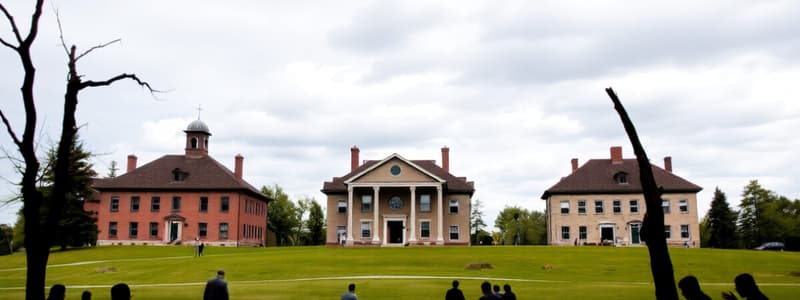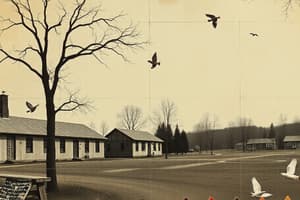Podcast
Questions and Answers
What was the primary purpose of residential schools in Canada?
What was the primary purpose of residential schools in Canada?
- To provide an education aligned with Indigenous culture
- To reinforce family values learned at home
- To promote cultural diversity among Indigenous students
- To assimilate Indigenous peoples into European Canadian culture (correct)
Which segment of the population was required to attend residential schools?
Which segment of the population was required to attend residential schools?
- Status Indians under the age of 16 (correct)
- Only Indigenous girls under 16
- Non-Indigenous children in rural areas
- All Indigenous children under the age of 18
In what year was attendance in Indian schools made compulsory?
In what year was attendance in Indian schools made compulsory?
- 1900
- 1932
- 1884 (correct)
- 1920
How did Duncan Campbell Scott view education in relation to Indigenous peoples?
How did Duncan Campbell Scott view education in relation to Indigenous peoples?
What impact did residential schools have on the cultural education of Indigenous students?
What impact did residential schools have on the cultural education of Indigenous students?
What was unique about the locations of residential schools in Canada?
What was unique about the locations of residential schools in Canada?
Which entity primarily operated residential schools in Canada?
Which entity primarily operated residential schools in Canada?
What broader societal issue does the legacy of residential schools relate to?
What broader societal issue does the legacy of residential schools relate to?
What factor contributed to the eventual closing of the schools?
What factor contributed to the eventual closing of the schools?
Who recommended the establishment of industrial schools for First Nations?
Who recommended the establishment of industrial schools for First Nations?
What legislative change made it mandatory for parents to send their children to school?
What legislative change made it mandatory for parents to send their children to school?
What action did the federal government take in 1969 regarding residential schools?
What action did the federal government take in 1969 regarding residential schools?
Which event marked the first public acknowledgment of abuse at residential schools?
Which event marked the first public acknowledgment of abuse at residential schools?
What did the 1948 Senate report emphasize regarding children's education?
What did the 1948 Senate report emphasize regarding children's education?
Which church made an apology to First Nations peoples in 1991?
Which church made an apology to First Nations peoples in 1991?
What crime was Arthur Plint convicted of in 1995?
What crime was Arthur Plint convicted of in 1995?
What was one of the primary goals of the residential school system in Canada?
What was one of the primary goals of the residential school system in Canada?
What emotional consequences did former residential school students often experience?
What emotional consequences did former residential school students often experience?
How might an Aboriginal Elder's interpretation of the photograph from St. Peter’s Mission differ from that of Duncan Campbell Scott?
How might an Aboriginal Elder's interpretation of the photograph from St. Peter’s Mission differ from that of Duncan Campbell Scott?
What type of abuse was associated with the residential school system?
What type of abuse was associated with the residential school system?
Which statement best represents a significant viewpoint on the impact of residential schools?
Which statement best represents a significant viewpoint on the impact of residential schools?
What did Matthew Coon Come suggest about the intention behind the residential school system?
What did Matthew Coon Come suggest about the intention behind the residential school system?
What long-term effects did former students of residential schools often report?
What long-term effects did former students of residential schools often report?
What aspect of the residential school system does the 1920s photograph illustrate?
What aspect of the residential school system does the 1920s photograph illustrate?
What was one positive outcome of the education received by Aboriginal children at the residential schools?
What was one positive outcome of the education received by Aboriginal children at the residential schools?
What did the residential schools inadvertently promote among Aboriginal leaders?
What did the residential schools inadvertently promote among Aboriginal leaders?
Which of the following describes the perspective of the former student regarding what was learned at residential schools?
Which of the following describes the perspective of the former student regarding what was learned at residential schools?
Why is there an irony in the impact of residential schools on Indian identity?
Why is there an irony in the impact of residential schools on Indian identity?
What can be inferred about media coverage of residential schools based on the content?
What can be inferred about media coverage of residential schools based on the content?
What role did education in residential schools claim to play in students' futures?
What role did education in residential schools claim to play in students' futures?
What might be a common misconception about the teachings in residential schools?
What might be a common misconception about the teachings in residential schools?
How did the experiences of children at residential schools differ based on their home environments?
How did the experiences of children at residential schools differ based on their home environments?
What was the primary focus of the First Nations Policing Policy implemented in June 1991?
What was the primary focus of the First Nations Policing Policy implemented in June 1991?
What event prompted the establishment of the Royal Commission on Aboriginal Peoples?
What event prompted the establishment of the Royal Commission on Aboriginal Peoples?
What phrase did Matthew Coon Come use to describe the potential actions of those with nothing to lose?
What phrase did Matthew Coon Come use to describe the potential actions of those with nothing to lose?
Which of the following protests is NOT mentioned as involving First Nations?
Which of the following protests is NOT mentioned as involving First Nations?
What implication does Coon Come's statement about drastic measures suggest about the federal government's role?
What implication does Coon Come's statement about drastic measures suggest about the federal government's role?
What does the term 'culturally appropriate police services' refer to in the context of the First Nations Policing Policy?
What does the term 'culturally appropriate police services' refer to in the context of the First Nations Policing Policy?
Which of the following was a direct consequence of the government’s failure to address Aboriginal issues?
Which of the following was a direct consequence of the government’s failure to address Aboriginal issues?
What is implied by the statement, 'If you've got nothing, you've got nothing to lose'?
What is implied by the statement, 'If you've got nothing, you've got nothing to lose'?
Flashcards
Residential Schools
Residential Schools
Government-funded, church-run schools that aimed to assimilate Indigenous children.
Indian Act (1884)
Indian Act (1884)
Made Indigenous children's attendance at residential schools compulsory.
Assimilation Policy
Assimilation Policy
The government's plan to absorb Indigenous communities into mainstream Canadian culture.
Royal Commission on Aboriginal Peoples
Royal Commission on Aboriginal Peoples
Signup and view all the flashcards
Truth and Reconciliation Commission
Truth and Reconciliation Commission
Signup and view all the flashcards
Cultural Loss
Cultural Loss
Signup and view all the flashcards
Social Consequences of Residential Schools
Social Consequences of Residential Schools
Signup and view all the flashcards
Indigenous Leadership
Indigenous Leadership
Signup and view all the flashcards
Policy of Assimilation
Policy of Assimilation
Signup and view all the flashcards
Physical and Emotional Abuse
Physical and Emotional Abuse
Signup and view all the flashcards
First Nations Policing Policy
First Nations Policing Policy
Signup and view all the flashcards
Loss and Separation
Loss and Separation
Signup and view all the flashcards
Cultural Suppression
Cultural Suppression
Signup and view all the flashcards
Compensation
Compensation
Signup and view all the flashcards
Residential School Civil Claims
Residential School Civil Claims
Signup and view all the flashcards
Confessions
Confessions
Signup and view all the flashcards
Indigenous Identity Revitalization
Indigenous Identity Revitalization
Signup and view all the flashcards
Violent Protests
Violent Protests
Signup and view all the flashcards
Ipperwash, Ontario
Ipperwash, Ontario
Signup and view all the flashcards
Burnt Church, New Brunswick
Burnt Church, New Brunswick
Signup and view all the flashcards
Study Notes
Residential Schools
- The Indian Act was amended in 1884 to make attendance in Indian schools compulsory for status Indians under the age of 16 until they reached 18 years of age.
- Government-funded, church-run Residential Schools were located in every province and territory except Newfoundland, New Brunswick, and Prince Edward Island.
- Some people in Canada believe that many of the social problems that Aboriginal communities face today are consequences, directly or indirectly, of the residential school system and the policy of assimilation that underlay them.
- Physical and emotional abuse was only part of the problem associated with residential schools.
- The goal of residential schools was to “take the Indian out of the Indian.”
- The first two residential school civil claims were filed in 1988.
- The Presbyterian Church offered First Nations peoples a confession in 1994.
- The federal government established the Royal Commission on Aboriginal Peoples in 1996.
- Other violent protests involving First Nations later took place at Ipperwash, Ontario (1995), Burnt Church, New Brunswick (2000), and Caledonia, Ontario (2006).
Social Consequences
- Children with terrible home lives and children whose parents wanted them to come went to the schools
- Some observers have pointed out that the Aboriginal children received in the schools has been at least partially responsible for the emergence of a newly powerful, well-educated leadership in the Aboriginal community.
- The residential school was designed to be the benign exterminator of Indian identity, but played a role in its perpetuation and revitalization.
- One student said that the school was "good teaching for survival in society" and he appreciated being able to learn all that.
- The government put into effect the First Nations Policing Policy in June 1991, which sought to improve the relationship between Aboriginal peoples and police.
Impact
- Some former residential school students were left with a deep-seated feeling of loss and separation from their families and cultures.
- Many Aboriginal people believe that the residential schools were designed to wipe out their culture and traditions, and that they were forced to assimilate into mainstream Canadian society
- These schools had a profound impact on the lives of First Nations people, and their legacy continues to be felt today.
- Aboriginal people have called for the government to apologize for the role it played in the residential school system and to provide compensation to survivors of abuse.
- The Truth and Reconciliation Commission of Canada was established in 2008 to document the history of residential schools and to hear from survivors about their experiences.
Studying That Suits You
Use AI to generate personalized quizzes and flashcards to suit your learning preferences.




